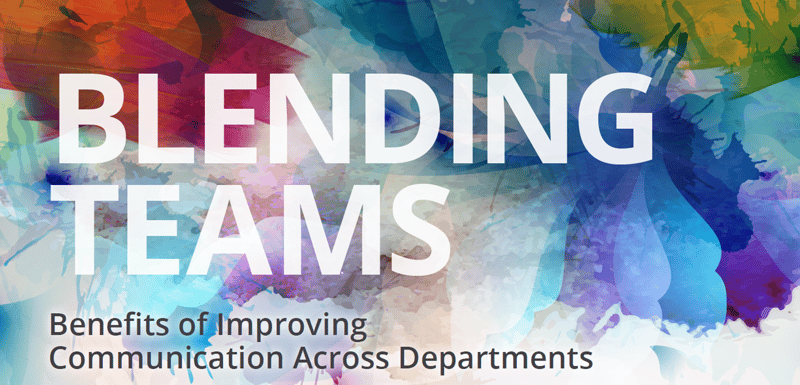
Cross-departmental communication is an aspect of business that is generally perceived as important, but it’s often overshadowed by more pressing day-to-day operations. Perhaps it is the abstract nature of the problem that makes it a troublesome issue to tackle. Where should a manager begin to address communication challenges? What is the most effective way to handle the blending of personalities and communication styles?
At SPS, we don’t have all the answers, but we have experienced these challenges and tried to adapt our structure to bring out the strengths of our teams. Here are some lessons we have learned along the way, tips from our team for building collaboration and open communication, and communication challenges and solutions through the lens of a clinical setting.
Communication Challenges in the Workplace
Exchanging information through interpersonal communication is vitally important in a clinical setting because it can lead to better patient outcomes. In an essay exploring designs of medical communication, Debra L. Roter observes, “Each participant relies on the specificity and precision of a shared abstract language to identify relevant concerns, construct a historical context, and plan an approach to care.” To put it another way, it’s like a tennis match where each player’s full attention is on their opponent. The server asks a question, the partner volleys a response, and back and forth they go. Just like nobody can play tennis alone, nobody can communicate without careful listening and sharing of feedback. Another aspect of interpersonal communication is non-verbal information, which is exchanged through body language. Signals in the form of facial expressions, gestures, eye contact, tone of voice, and posture have the power to build positive connections between clinicians, patients, and colleagues.
Poor communication within healthcare is unnervingly common. A study by researchers at Johns Hopkins Medicine estimates that over 250,000 Americans die each year from medical errors, ranking as the third leading cause of death behind heart disease and cancer. Patients are caught in the crossfire when communication breaks down. The Joint Commission cites communication failures as the major cause of adverse events, including wrong-site surgery, treatment delay, falls, and medication errors. The reasons for communication barriers are wide ranging. A study by VHA West Coast identified common reasons why nurses were reluctant or refused to call physicians, including intimidation, fear of getting into a confrontational or antagonistic discussion, lack of confidentiality, fear of retaliation, and the fact that “nothing ever seems to change.” The negative results of poor communication can be grim, which is why cultivating this skill is important for not just interpersonal relationships, but for patient outcomes.
Communication challenges are not unique to any business. At SPS, we identified a challenge that spanned three departments: sales, inside sales support, and accounts receivable. “Originally, accounts receivable would manage customers based on where they fell alphabetically,” says Accounting Manager Randy Schuman.
An accounts receivables rep would manage a portion of customer accounts organized by the alphabet, while a sales rep and an inside sales support specialist managed accounts by region. These differences resulted in multiple calls placed between sales and accounts receivables and some confusion on who managed which customer accounts.
“We had a lot of hands in the pot,” Shuman notes.
Misaligned departments can be a huge drain on efficiency. In our case, we needed to shift the account receivables department to improve the workflow between departments. Shuman explains, “We created customer service pods to align a salesperson with one inside sales support specialist and one collections specialist. It really gave the team focus on who to work with inside the company. From a customer standpoint, the customer knows exactly who to speak to with any kind of issue.” Pinpointing inefficiencies and reorganizing resources can provide much needed relief to staff, no matter the business.
Positive Pod Outcomes
Implemented in January 2020, the customer service pods include one accounts receivables rep who is matched with two sales account managers and their inside sales support specialist. The customer service pods contributed to building a stronger culture of collaboration within the company. “If somebody needs help with an account, they are encouraged to ask around for ideas. They work together to support customers in whatever way they need,” Shuman says.
The pods created mini workgroups dedicated to solving customer issues. Sales Account Manager Eric Fuller says this about his pod, which he dubbed Team Awesome, “Obviously we’re co-workers, but I think we’re friends, too. If there is a genuine need, we react as friends. It’s just the community we built between the three of us.”
In a clinical setting, collaboration is defined as “healthcare professionals assuming complementary roles and cooperatively working together, sharing responsibility for problem-solving, and making decisions to formulate and carry out plans for patient care.” Each individual in a team brings their own skills and expertise that can improve decision-making. Collaboration can also improve morale for individuals on the team. According to a UK study, “improved teamwork and communication are described by healthcare workers as among the most important factors in improving clinical effectiveness and job satisfaction.”
The customer service pods have also bolstered open and honest communication within the teams. Before, an accounts receivables rep could have 20-plus individuals attached to a variety of customer accounts. With so many people, it was difficult to connect on a personal level. Shuman observes, “Working with just one dedicated accounts receivables rep has really cemented a good working relationship across the departments.” The teams are able to emotionally connect now that they are working closely with the same group of individuals every day. “Some people keep everything bottled up, and you don’t know what’s going on in their life. Not that you’re trying to poke into their private life—but if they’re dealing with something major and they just haven’t told you, it’s important to communicate openly. In this structure, you should be able to speak openly and honestly,” Shuman says.
When asked about how their pod has cemented a close working relationship, Fuller says, “There’s not a lot of secrets to our success. It’s about communication and troubleshooting and being open and honest.” Health facilities often employ the hierarchical organization structure, where higher and lower-level positions handle care within their division. This structure can create power distances between clinicians and other staff members, leading to a culture of restraint. A study by Denver Health Medical Center found that implementing educational programs designed to disrupt these structures can enhance teamwork and communication.
It may seem counterintuitive, but another strategy for encouraging teamwork is by creating divisions—as in divisions of labor. Shelia Coy has worked in returns and customer service prior to transferring to her current position as a collections specialist. “Once I transferred from customer service, I lost a lot of access to software that I previously had,” she says. “In the pods, we truly have to work as a team and rely on each other for the things we can and can’t do.”
While some cross-training exists, many tasks are defined to an individual’s role in an effort to reduce work stress and ease workload. Coy continues, “I hope what I’m able to bring to the team has taken some pressure off Sales Account Manager Hunter to allow him to focus on the things he needs to do. I don’t feel like it’s his responsibility to handle all problems, especially on the accounting side. I want to do anything I can to take that load off his shoulders, and free up time for him to manage customer accounts.” A divide-and-conquer approach can accentuate the strengths of individuals within a team, but it can come at the expense of coordination costs as hand-off and communication needs increase. Balancing a team’s workload against staffing constraints is not an exact science that can apply to all business circumstances, so it’s important to explore what is the best fit for your teams.
Overcoming Communication Challenges
Building relationships is a challenging aspect of any job. Inside Sales Support Specialist Robin Hester provides advice for overcoming this barrier. “You have to find common ground. Some coworkers are closer than others, or have worked longer. Your personality isn’t always going to match with somebody else, so you have to find something that you have in common.”
 Fuller agrees. “Let’s be honest, not all people are going to like each other, but at the end of the day, it’s about trying to find that common ground and that common goal that gets things done.” All clinicians have at least one thing in common: the desire to improve a patient’s mobility. For anyone struggling to make a connection, starting with a commonality can help nudge the relationship closer together. Hester advises to not get discouraged if personalities do not mesh. “Give it time. Some relationships take longer than others, no matter if they’re personal or professional. You just have to give it time.”
Fuller agrees. “Let’s be honest, not all people are going to like each other, but at the end of the day, it’s about trying to find that common ground and that common goal that gets things done.” All clinicians have at least one thing in common: the desire to improve a patient’s mobility. For anyone struggling to make a connection, starting with a commonality can help nudge the relationship closer together. Hester advises to not get discouraged if personalities do not mesh. “Give it time. Some relationships take longer than others, no matter if they’re personal or professional. You just have to give it time.”
Another way to mitigate communication barriers is to keep the end goal in mind. Shuman explains, “I am one of those people that believes everyone is trying to do their best job. So if you’re having trouble, it’s most likely a communication issue. I mean, in the big picture, we all want to be treated with respect, we want to be treated with kindness. We all have our different strengths. When you’re telling someone how to do something, you hope they understand it, but if they don’t do it the way you do or don’t understand, have patience and keep working to help the person. It’s easy to be kind.”
Keeping a high-level view of office relationships is important. Coy adds that understanding the end goal can also help relieve work tensions. “The biggest thing is to remember that it’s not a competition. We’re not trying to outdo the other. We’re trying to work together to do what’s best for our customers so they can do what’s best for their patients. Many decisions we make are based on the patients that our customers serve.”
Coy has firsthand experience with patients. “I’ve experienced multiple perspectives throughout my career. I’ve worked at an independent clinic that was a customer at SPS, and my husband is an amputee. The most important thing is providing to that customer so they can make a better life for the patient. In the back of my mind, I’m always thinking, ‘How would my husband feel if he went to a clinic and they told him they did not have the supplies needed for a fitting?’” Taking a step back to appreciate the collective goal can align departments and motivate the teams to do their best.
The art of communication is full of fumbles and gaffes. Businesses large and small struggle to bolster transparent communications across teams. While the consequences of communication barriers can be dire for patients, cultivating effective communication can have a multitude of positive outcomes, such as improved clinical quality, experience of care, and financial outcomes. Consider how improving communication in your clinic can help you achieve your goals—and if you ever need help, know that you can reach out to your dedicated customer service pod at SPS.
Discover your customer service pod.
Click below to view the original feature from The SPS Xpress.



